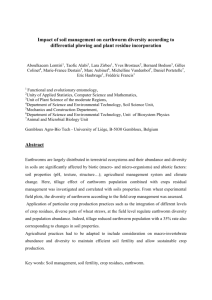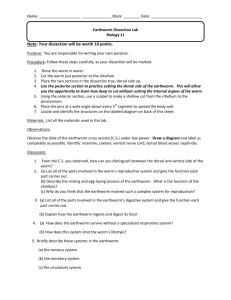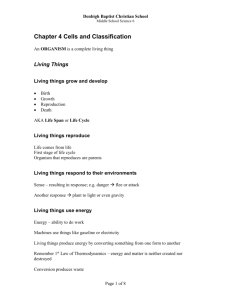Invertebrates_Chap15 - Denbigh Baptist Christian School
advertisement
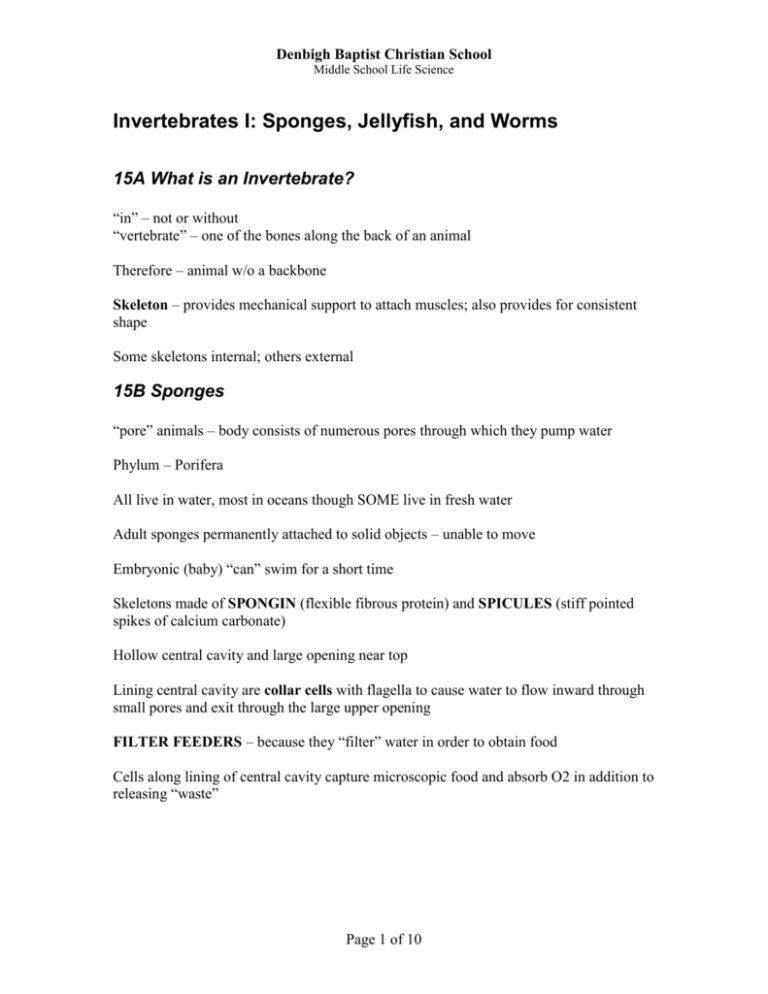
Denbigh Baptist Christian School Middle School Life Science Invertebrates I: Sponges, Jellyfish, and Worms 15A What is an Invertebrate? “in” – not or without “vertebrate” – one of the bones along the back of an animal Therefore – animal w/o a backbone Skeleton – provides mechanical support to attach muscles; also provides for consistent shape Some skeletons internal; others external 15B Sponges “pore” animals – body consists of numerous pores through which they pump water Phylum – Porifera All live in water, most in oceans though SOME live in fresh water Adult sponges permanently attached to solid objects – unable to move Embryonic (baby) “can” swim for a short time Skeletons made of SPONGIN (flexible fibrous protein) and SPICULES (stiff pointed spikes of calcium carbonate) Hollow central cavity and large opening near top Lining central cavity are collar cells with flagella to cause water to flow inward through small pores and exit through the large upper opening FILTER FEEDERS – because they “filter” water in order to obtain food Cells along lining of central cavity capture microscopic food and absorb O2 in addition to releasing “waste” Page 1 of 10 Denbigh Baptist Christian School Middle School Life Science 15C The Jellyfish: A Cnidarian Phylum Cnidaria Tentacles with stinging cells Usually found in oceans; occasionally in fresh water 15C.1 The Body of a Jellyfish Primary support is “jelly” like mass that fills space between two layers of tissue Hydrostatic skeleton – similar to a water balloon; water provides support Large central cavity surrounded by two layers of tissue Tentacles surround the “mouth” (only body opening) Ectoderm – outer tissue layer Endoderm – inner tissue layer Gastrovascular cavity – inside where jellyfish digests food Food enters mouth and waste leaves Network of nerves throughout the body but no brain to coordinate reactions 15C.2 Jellyfish Activities Tentacles contain NEMATOCYSTS – special cells in the ectoderm Nematocysts contain a “trigger” which causes a thin tube to be forced out Poison is forced through this tube Weak muscle fibers can push food into the mouth and into gastrovascular cavity Enzymes are released in the endoderm to break down food Food enters vacuoles Waste expelled through the mouth Page 2 of 10 Denbigh Baptist Christian School Middle School Life Science Jellyfish can “swim” by squeezing out water like a water jet resulting in slow jerky motion 15C.3 Other Interesting Cnidarians Hydras Corals Sea anemones Portuguese man-of-war (up to 50 ft long) Cnidarians have radial symmetry along length of body – no defined left/right side though they do have a definite TOP and BOTTOM 15D The Planarian: A Flatworm The term “plane” comes to mind … flatworm Bilateral symmetry – prefix “bi” implies 2; lateral length wise Mirror images along center-line Phylum Platyhelminthes Free-living – often found in freshwater streams and in soil Implies NOT a parasite 15D.1 The Planarian’s Nervous System Most animals control bodies via neurons NEURONS – long, thin nerve cells that carry impulses from one point to anther Kind of like computer communication cables or phone lines Nervous systems become complex, some sort of “director” required GANGLION – director or coordination center Planarians have longitudinal nerves (two of them) running down the length of the body Across (tranverse) the body is additional nerves. The appearance of nerves is like a ladder Page 3 of 10 Denbigh Baptist Christian School Middle School Life Science Like humans, planarian’s ganglia coordinate response to stimuli (something an organism can sense). There is keen sense of smell and light. Smell likely important for location of food 15D.2 The Planarian’s Digestive and Excretory Systems Cilia on underside help planarian to “glide” over underwater surfaces. Mouth located on underside Inside mouth is long branching cavity – intestine Intestine lined with layer of cells – GASTRODERM “Eating” is accomplished by extending PHARYNX through mouth and “sucking” food into intestine. Enzymes are excreted to begin digestion of food Gastroderm absorbed small pieces of food after enzyme effect. Cellular digestion completes the process. Non-digested material – expelled from intestine through mouth Intestine extends to all portions of body Planarian is about thickness of a sheet of paper Size allows for exchange of O2 and CO2 directly with environment 15D.3 Other Interesting Flatworms Tapeworms, flukes and marine flatworms Tapeworms – common parasite of animals and humans Found in digestive tract (attaches itself) “sucks/absorbs” digested food Many segments (reproductive in nature) fill with eggs. Exit body via waste excrement Page 4 of 10 Denbigh Baptist Christian School Middle School Life Science Parasitic worms in humans are unpleasant and harmful 15E Roundworms Phylum Nematoda Round, tubular bodies with tapered ends Some are parasites 15E.1 Ascaris – A Common Roundorm Often found in intestines of various animals Release eggs into animal’s intestines that exit via feces Tiny eggs are often swallowed by grazing animals beginning the process again 15E.2 Other Interesting Roundworms Hooksworms Pinworms Trichina worms Vinegar eel 15F Segmented Worms Earthworm has long, slender body with a series of segments Phylum Annelida Leeches Tubeworms Scale worms Sandworms Fireworms Page 5 of 10 Denbigh Baptist Christian School Middle School Life Science 15F.1 The Body of an Earthworm Epidermis covers body Epidermis exchanges gases (CO2 and O2) with environment Secretes a thin outer coating – cuticle which protects from parasites and “stuff” Two muscles layers for support and motion One is “circular” and changes the diameter of the worm When diameter changes, length necessarily changes with it Second muscle layer is longitudinal which can lengthen/shorten the worm Movement is in multiple steps Bristles in “rear” are extended to anchor the rear Circular muscles contract causing diameter to decrease AND lengthening worm Bristles in “front” extended to anchor and bristles in rear are retracted Longitudinal muscles contract causing diameter to increase and length to shorten 15F.2 The Earthworm’s Nervous System Sensory receptor – structure that can sense a stimulus and start an impulse along a neuron Located over the body of an earthworm Sensitive to Chemicals Light Temperature Other More receptors at “front” than anywhere else Since “leads” with front, helps to distinguish between food and danger Page 6 of 10 Denbigh Baptist Christian School Middle School Life Science Two large ganglia located in 3rd segment (diagram 15F-3 page 278) Nerve cord (bundle of nerves) located in lower half of earthworm Small ganglia located in each segment along the cord Ganglia interpret impulses and worm decides what to do Interprets and decides – however this doesn’t imply intelligence as very little is present Ganglia takes input from sensory receptors and “informs” muscles, bristles and other structures Page 7 of 10 Denbigh Baptist Christian School Middle School Life Science 15F.3 The Earthworm’s Digestive System Often eats “soil” as it forms tunnels Most of soil is indigestible and or non-food Some of the ingested soil contains decaying leaves, fungi and small creatures Digestive tract is long, straight Enlargements, constrictions, infoldings and glands along the way … each with own function in digestion process Mouth scretes fluids to moisten soil Upper lip forces food into mouth Connected to mouth is pharynx (FEHR inks) Glands secrete fluid into pharynx to lubricate food passing through Muscle fibers contract to help “pull” food into earthworm Esophagus (ih SAHF uh gus)– tubular passageway to carry food from pharynx to crop CROP -- temporary storage chamber Food passes from crop to “gizzard” … yet another “bulge” in digestive tract Muscles in gizzard walls contract and relax pushing gizzard walls in/out Gizzard performs mechanical digestion by “grinding” food particles against sand and grit particles Ground-up food passes to intestine of earthworm Digestive enzymes in intestine (from cells in intestinal tract) continue digestion “outside” the cell breaking food down into soluble materials Inner intestinal wall has folds with ridges to provide extra surface area for absorbing of food Food molecules are absorbed through intestine into blood vessels Page 8 of 10 Denbigh Baptist Christian School Middle School Life Science Blood vessels carry food to all the cells Indigestible “food” passes through intestines and exit via the anus frequently accumulating in “piles” outside tunnels. Piles are called castings. 15F.4 The Earthworm’s Circulatory System Continuous network of blood vessels Blood remains “inside” vessels Closed circulatory system – blood never leaves blood vessels Large dorsal blood vessel (along the back; dorsal – back) acts like the heart Dorsal blood vessel “pumps” blood to 5 sets of aortic arches which essentially makes this “function” like a heart and controls blood pressure Blood passes through aortic arches to ventral blood vessel (ventral – belly) Ventral blood vessel carries blood along “bottom” to every segment Smaller arteries branch from ventral blood vessel From the smaller arteries blood travels to CAPILLARIES Walls of capillaries are very thin and allow substances to pass between blood and earthworm’s tissues. Blood flows from arteries through capillaries to VEINS. VEINS – carry blood toward the heart This type of system is known as “closed circulatory” Page 9 of 10 Denbigh Baptist Christian School Middle School Life Science 15F.5 The Earthworm’s Respiratory and Excretory Systems No special respiratory structures O2 and CO2 exchange through moist skin O2 received through skin transfers to blood in capillaries In an emergency, earthworm CAN go w/o new O2 for several hours During heavy rainstorm – burrows fill causing earthworm to come to the surface to get O2 All but first and last few segments have EXCRETORY TUBULES through which waste is excreted through tiny pores on the surface of earthworm Page 10 of 10

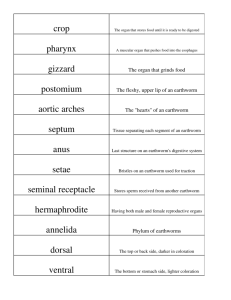
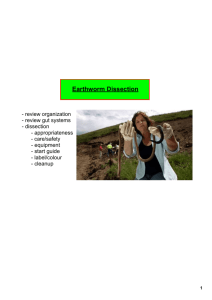
![Earthworm Lab [1/16/2014]](http://s3.studylib.net/store/data/007071636_1-f0a789e538fb90aecda95ecf7b0a3557-300x300.png)
